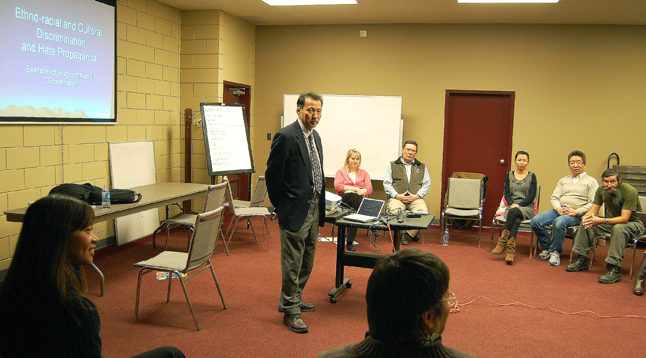
By David F. Rooney
Overt racism may not be a major problem in Canada any more, but prejudice and subtle forms of discrimination still linger, say UBC Associate Professor Ishu Ishiyama and Angela Brown, a racism and diversity consultant to the Vancouver School Board.
“Racism is not a huge problem in Canada,” Ishuyama told a group of 16 people he met at the Community Centre for an introductory workshop on active witnessing, a technique he promotes as a tool people can safely use to intervene when they see acts of racism or discrimination. “But as more people of different races and backgrounds come here there are bound to be conflicts.”
It’s easy to imagine that British Columbia and he rest of Canada have always been accepting and inclusionary when it comes to newcomers. After all, didn’t just about everyone except First Nations people come here from somewhere else? That is true, but a slideshow Ishiyama shows that the past was distinctly uglier. There were proscriptions against immigration by Asians in the early years of Canadian national history, the infamous Komagata Maru incident in 1914 and public meetings and even riots against what was called “the Yellow Peril,” meaning immigration by Chinese and Japanese people in the 1920s. Then there was the expropriation of Japanese-Canadians’ property and their forced internment in camps in the Interior during the Second World War and other dark chapters most Canadians would just as soon forget.
Episodes like those are, thankfully, in the past, but prejudice and discrimination linger on. Women, gays, lesbians, young people, the disabled, natives and other people of different racial, linguistic, religious and ethnic backgrounds are still targets for those who feel hatred or contempt for others.
Acts of discrimination likley have their some of their roots in the need for haters to feel empowered and so incidents still occur. They can be as simple as saying, “No” to someone looking for work or a place to live for no better reason than you don’t like the smell of their cooking or the kink in their hair. Or they can be acts of outright harassment or ridicule, sometimes even in public.
It is incidents like those that Ishiyama and Brown were trying to address here through an Okanagan College-sponsored series of Anti-Discrimination Response Training workshops on Wednesday and Thursday. A day-long seminar at the college’s Farwell Centre campus and a two-hour seminar for local students, teachers and principals an the SD 19 boardroom sought to teach participants how to become active witnesses willing to safely intervene when they witness an act of discrimination or racism.
That’s a tough thing to do. Many, perhaps even most, adults have probably found themselves in situations where they’ve seen or heard someone being harassed or abused. What was their response. For a great many it was probably this: look away and don’t get involved; pretend nothing happened.
That may be a natural response because most people prefer to avoid confrontation, but it is the wrong one because it will likely be interpreted by the abuser as tacit approval.
Active witnessing by someone watching what’s going on can defuse the situation, safely rescue the victim and gently force the abuser to back off. An active witness can stop what’s happening by doing something as simple as standing beside a victim or by loudly pointing out that the abuser’s language is hurtful and morally repugnant. Or they can enlist others to help out using their body language and spoken words to stop the scenario from escalating.
“Silence can be interpreted as a sign of… approval of the offence,” Ishiyama said. “Active witnessing is a response you can use to counter that.”



